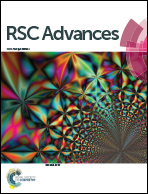TiO2 nanoparticles vs. TiO2 nanowires as support in hydrogen peroxide direct synthesis: the influence of N and Au doping†
Abstract
The performance of Pd on titania support were evaluated in the direct synthesis of hydrogen peroxide. The equipment used was a high pressure, semi-batch apparatus equipped with a special injection system. Pd (1 wt%) catalysts on TiO2 materials with different nature were prepared by wet impregnation method. Three aspects were investigated: (a) the structure of the support (nanoparticles vs. nanowires); (b) the addition of a second active metal (Au); (c) the influence of N-doping of the support. All samples were characterized by means of XPS, TEM and XRD analyses. TiO2 nanoparticle supported catalyst demonstrated higher H2O2 selectivity and higher turnover frequency (TOF) than the catalysts based on TiO2 nanowires. The addition of Au to the Pd TiO2 nanowire catalyst improved the H2O2 selectivity due to altered particle size and electronic effects. Both N-doped versions of the catalysts gave rise to higher H2O2 selectivity than the parent non-doped ones. The synthetic procedure was the source of this observation: larger mean Pd nanoparticles were present, thus favouring the formation of H2O2 as the primary product.



 Please wait while we load your content...
Please wait while we load your content...